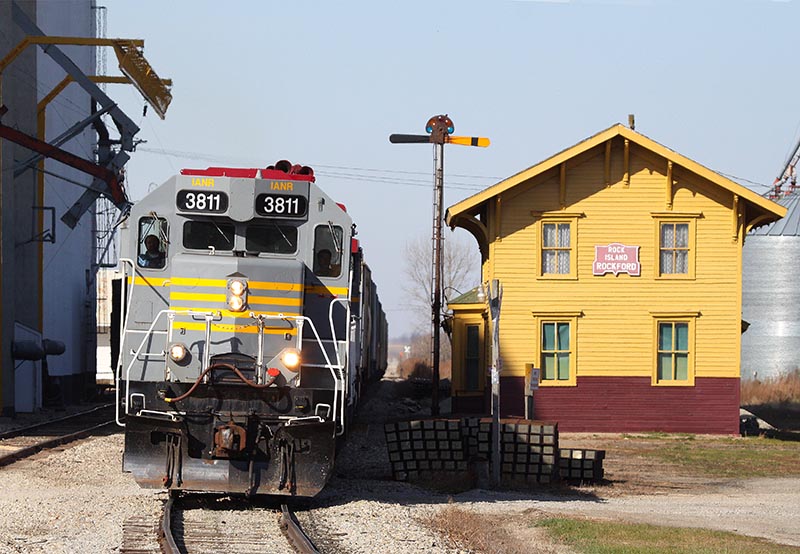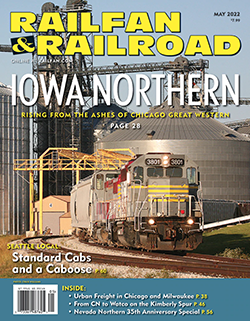 By Jim Rowland/photos as noted
By Jim Rowland/photos as noted
It is said that at the zenith of rail operations in the state of Iowa, there was no location in the state more than a dozen miles from an active rail line. No doubt, the expansive lines of Chicago & North Western, Rock Island, Illinois Central, Milwaukee, and Burlington that spanned the state in a quest to directly connect Omaha, Neb., with Chicago led to an overabundance of rail corridors. Include north-south carrier Minneapolis & St. Louis, as well as scores of smaller railroads, and it is easy to see how the initial claim came about. In 1892, one final carrier emerged — Chicago Great Western.
As the last carrier constructed and never financially robust, CGW was not the fastest, best engineered, or most direct route between both points. John W. Barriger III famously described CGW as “a mountain railroad built in prairie territory serving a traffic vacuum.” CGW went where everyone else already did and managed to miss almost every city of consequence along the way. However, its mains from Minneapolis and Kansas City, Mo., funneled considerable traffic toward Chicago. All four of CGW’s main lines had a common point of convergence in Oelwein. As such, Oelwein was given the nickname “The Hub City.” It was here that CGW established its main locomotive and car shops, which between 1904 and 1910 were capably supervised by none other than future automotive mogul Walter P. Chrysler.
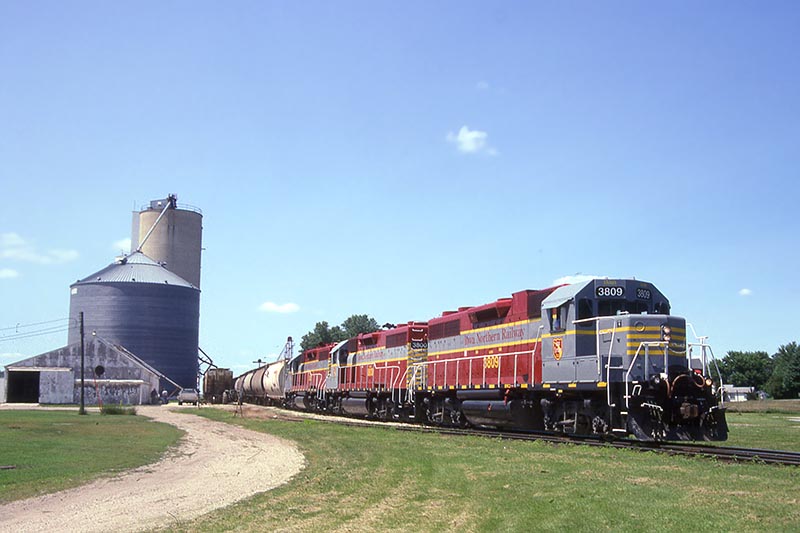
ABOVE: Iowa Northern, an Iron Road Railways property from November 1994 until January 2003, also adopted a variation of Iron Road’s Canadian Pacific-inspired scheme. A trio of IANR GP38-2s works at Marble Rock, Iowa, on June 28, 2004. —Jim Rowland photo
Being the last of six trans-Iowa routes, CGW had to be innovative to stay ahead of the competition, and to that end, it was quite progressive for its time. CGW gained national recognition for its early use of offline sales offices, contract rates, and purchase of agricultural commodities for the purposes of freight traffic. An example of CGW’s success was that in 1896, the carrier transported 70 percent of all corn moving between Kansas City and Chicago. CGW inaugurated trailer-on-flatcar service between Chicago and St. Paul, Minn., in 1936, and three years later between Chicago and Council Bluffs. CGW was one of the first carriers to experiment with welded rail.
Operating approximately 1,450 miles of track, CGW was not a particularly large system. By the mid-20th century rail mergers and consolidations became not only the way of the future, but necessary tools for survival. The 1963 announcement of the planned merger between Union Pacific and Rock Island threatened the interchange traffic received from UP at Omaha and Kansas City. Faced with this loss of traffic, CGW began to search for merger partners of its own, and in the end, selected Chicago & North Western. On July 1, 1968, the Corn Belt Route passed into history.
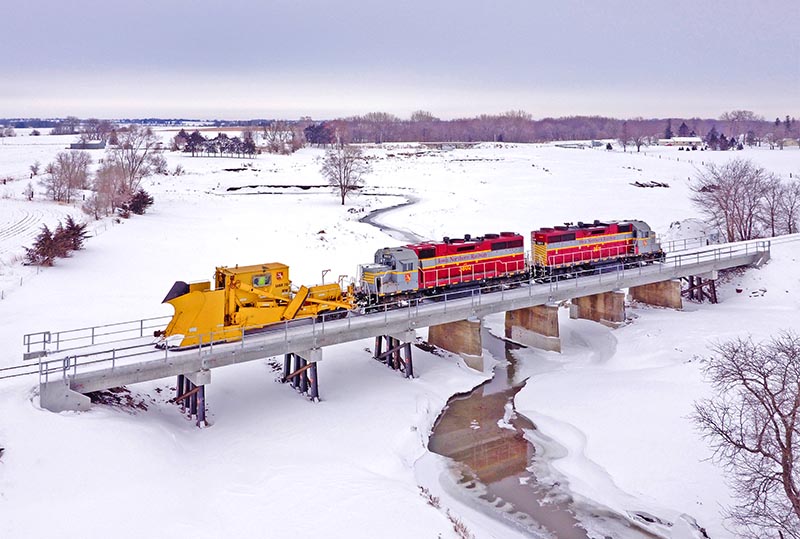
ABOVE: An IANR plow train using a Jordan Spreader crosses over Elk Run near Dewar on February 10, 2021. The new concrete bridge over Elk Run is indicative of the work performed to upgrade the line to handle ethanol traffic. —Aerial photo by Craig Williams
The acquisition of CGW provided a gateway into Kansas City, something C&NW previously lacked. It had been widely postured that this gateway, as well as the Oelwein shops, was the sole reason for the acquisition. The duplicate lines were downgraded and eliminated as quickly as possible.
Oelwein’s locomotive backshop was a different story. This CGW asset gave C&NW something it did not possess — a large facility featuring modern equipment in a relatively central location that was capable of doing heavy repairs and rebuilds for the entire C&NW system. Oelwein’s excess facilities, such as the old roundhouse, were no longer needed, and were acquired by Transco on August 1, 1969, for car repair operations.
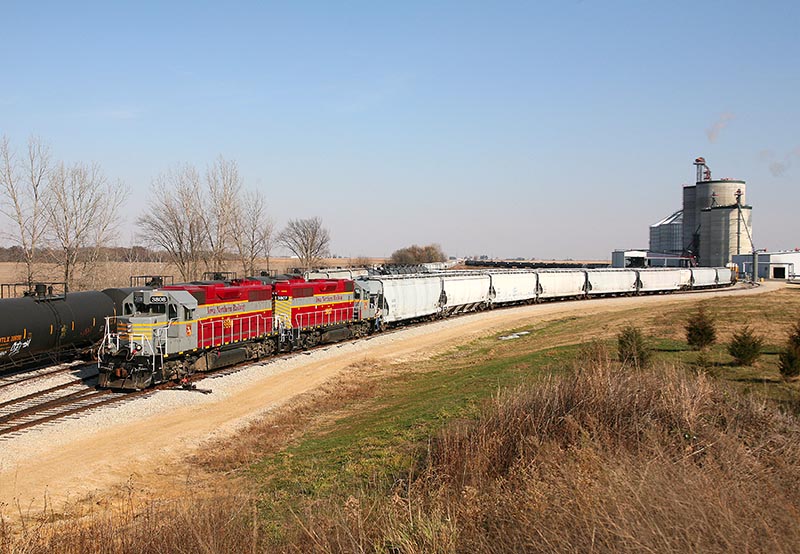
ABOVE: An IANR crew works the Fairbank ethanol plant on November 4, 2008. Prior to the opening of this plant in 2008, it had been decades since this segment of the old CGW had seen this type of traffic. —Craig Williams photo
From Hub to Stub
In a state with excess rail capacity, duplicate trackage was destined to be rationalized. C&NW became notorious for downgrading and abandoning hundreds of miles of its acquired former major rivals. For the former CGW routes out of Oelwein, portions of the Chicago main in Illinois were the first to be taken out of service in late December 1968, and removed in 1973. CGW’s Council Bluffs main at its western end was the next to be severed, in August 1971.
Though much of CGW was plagued with inferior grade profiles, a multitude of curves, light rail, and mostly unsignaled dark territory, the remaining lines still served major markets and were kept busy through the 1970s. C&NW invested little in the way of track upgrades, performing only the bare minimum. By the end of the decade, after being run into the ground with heavy trains, major track rehabilitation was needed.
The March 31, 1980, collapse of neighboring Rock Island brought an opportunity for C&NW to acquire a superior line with an abundance of online business, while simultaneously bringing about a swift end for much of the remaining CGW. As far back as the mid-1970s, North Western knew it had issues with the CGW line into Kansas City. As stated in a publication from the C&NW Historical Society, Ed Burkhardt (of Wisconsin Central fame) did an extensive study while he was with C&NW. His study determined that part of the line had too many curves, too many hills, was prone to flooding, had no CTC, and had few sidings of any adequate length. A retired C&NW engineer stated that by 1980, a hi-rail inspection truck ran ahead of every train checking for defects. It took crews five days to make the round trip between Kansas City and Des Moines…


